|
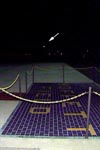
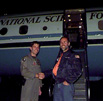
The NSF/NCAR Electra aircraft approaching the Ames runway at Moffett Field on November 5
(right),
signaling the start of the 1998 Leonid MAC mission. Capt. Steve Butow welcomes
mission coordinator Dr. Bruce Moreley of NCAR.
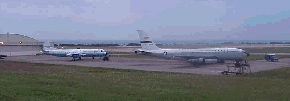
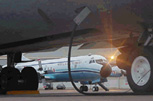
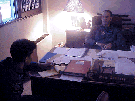
Electra and FISTA parked at Kadena AFB in Okinawa on November 17.
Maj. Lamarche of the USAF/18th OSS discusses with Capt. Butow
the logistic effort at Kadena AFB.

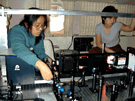
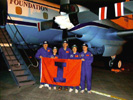
The main instrument onboard the Electra aircraft: the two-beam Iron Bolzmann
Lidar of the University of Illinois at Urbana. This instrument consists of two lasers
that send light pulses up to the meteor layer at two different wavelengths.
Two large telescopes watch the tip of
the laser beams and record when the light is absorbed and re-emitted by iron atoms,
or scattered by dust. The time
it takes the light pulse to go up and down determines the distance to the
absorbing iron atoms or scattering dust. This technique allows the detection of
meteor atom debris trails and the background iron
debris layer. The instrument is used to weigh meteors and measure the chemical
and physical timescale on which iron atoms react with the atmosphere or are otherwise
removed from the trails and the debris layer.
The images show Xinzhao Chu and Weilin Pan of the University of Illinois tuning the lidar.
The 5 person strong team of the University of Illinois (right) took pride in their participation.
Instrument PI, Dr. Chet Gardner, was crucial in making it possible to have Electra
participate in the mission.

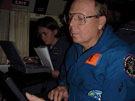
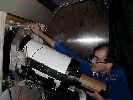
Dr. Gary Swenson of the University of Illinois while operating the airglow camera (right,
behind an optical glass dome),
and Beverley Allan of the University of East Anglia while tuning the UEA spectrometer (left,
mounted on a specially built gimbal).

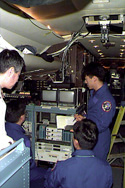
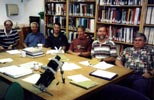
Left, Mike Wilson operating the SETI Institute high-resolution meteor spectrograph.
The Japanese Broadcasting Company (NHK) contributed High-definition TV cameras.
The Electra camera was mounted in the ceiling of the aircraft and protected from
vibrations by a special mount.
Right, the Electra crew of the National Center for Atmospheric Research (NCAR)
Research Aviation Facility in Broomfield, Colorado,
in a pre-event meeting, discussing the use of the two intensified
cameras for meteor imaging on the Electra aircraft.
(<<)
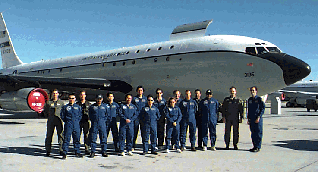
At the 452nd Flight Test Squadron at Edwards AFB, experimenters just finished
the instrument installations on FISTA.
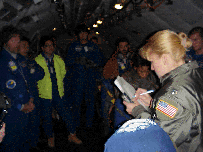
Before takeoff, instructions on the use of oxygen bottles (the green
bags carried by the researchers), the use of the intercom system (the headphones)
and general safety issues.
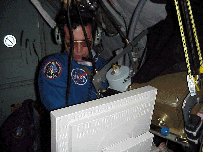
Dr. George Rossano of Aerospace Corporation operating the new MIRIS spectrograph,
who got its maiden flight during Leonid MAC. The spectrograph aimed to record
meteors at wavelengths between 3 and 5.5 micron and was one of two mid-IR
spectrographs contributed by the Aerospace Corporation. These instruments were the
most ambitious onboard the FISTA mission and involved cooling with liquid nitrogen and
helium in order to detect the heat of meteors.
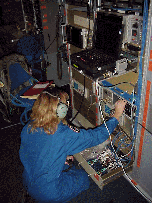
Dr. Sandy Niermann of AFRL examines the results from the Michelson
spectrometers. An experienced airborne researcher and member of the FISTA
program, Sandy and her team have spread the bed for the other researchers
on board FISTA. This instrument was one of several that are routinely flown
on FISTA and aimed at high resolution spectroscopy of persistent trains.
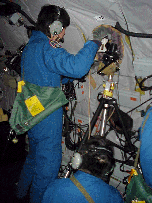
Dr. Ryosuke Nakamura and assistant Yasumasa Fujii of the University of Kobe, Japan,
operate a CCD camera for the measurement of the faint glow of scattered
sunlight off the particles in space. The finest grains are most efficient in
scattering sunlight and this experiment aims to measure the content of grains in
the shower that are too small to be detected as meteors. The glow has only been
reported in anecdotes of past storms and has never been recorded.
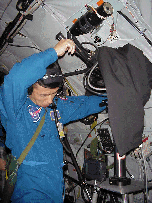
Mr. Satoshi Yamaguchi of the Japanese Broadcasting Company, NHK, adjusts an
intensified high-definition TV camera for high resolution images of meteors
and trains in an experiment by Dr. Hajime Yano.
Two intensified cameras on FISTA and Electra aim to observe the
meteors from in stereoscopic manner for the determination of trajectories
and orbits.
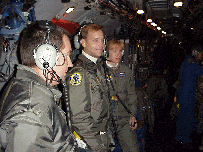
The mission crew of the 452nd Flight Test Squadron makes sure that
all activities proceed safely and the researchers are in close contact by intercom at
all times.
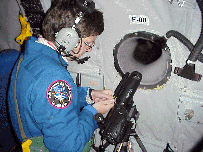
Dr. Jiri Borovicka of the Czech Republic, an expert in meteor spectroscopy,
operates a spectrometer at one of the FISTA windows.
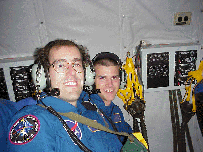
A satisfied Project Scientist Dr. Peter Jenniskens, with Ian Murray behind him, after a
successful test flight on November 9 over Edwards Air Force Base.
(<<)
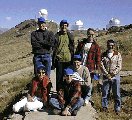 Team of astronomers preparing to observe the 1997 Leonids from the European Southern Observatory, Chile (81K). Posing in front of the 3.6, CAT, NTT, and 2.2m telescopes, from left to right are the astronomers: (down:) Agnes Lebre, Jean Mouette, Giacomo Mulas, (top:) Stephane Guisand, Peter Jenniskens, Renaud Moliton, and Licio da Silva. Not in the image are participants Jiri Borovicka, Matthew Shetrone and Paul Goudfrooij. Image courtesy: Peter Jenniskens (NASA/ARC). Team of astronomers preparing to observe the 1997 Leonids from the European Southern Observatory, Chile (81K). Posing in front of the 3.6, CAT, NTT, and 2.2m telescopes, from left to right are the astronomers: (down:) Agnes Lebre, Jean Mouette, Giacomo Mulas, (top:) Stephane Guisand, Peter Jenniskens, Renaud Moliton, and Licio da Silva. Not in the image are participants Jiri Borovicka, Matthew Shetrone and Paul Goudfrooij. Image courtesy: Peter Jenniskens (NASA/ARC).
 Team of amateur astronomers of the
Dutch Meteor Society, preparing to observe
the 1995 Leonid outburst. Image courtesy of Hans Betlem (DMS).
Team of amateur astronomers of the
Dutch Meteor Society, preparing to observe
the 1995 Leonid outburst. Image courtesy of Hans Betlem (DMS).
 Visual observers of the Dutch Meteor Society team in Almedinilla (southern Spain)
during a practise and photo-shoot prior to the Leonid night of November 16/17, 1995.
Photo: courtesy of Hans Betlem (DMS).
Visual observers of the Dutch Meteor Society team in Almedinilla (southern Spain)
during a practise and photo-shoot prior to the Leonid night of November 16/17, 1995.
Photo: courtesy of Hans Betlem (DMS).
|
